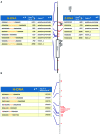Detection of cis- and trans-acting Factors in DNA Structure-Induced Genetic Instability Using In silico and Cellular Approaches
- PMID: 27532010
- PMCID: PMC4969553
- DOI: 10.3389/fgene.2016.00135
Detection of cis- and trans-acting Factors in DNA Structure-Induced Genetic Instability Using In silico and Cellular Approaches
Abstract
Sequences that can adopt alternative DNA structures (i.e., non-B DNA) are very abundant in mammalian genomes, and recent studies have revealed many important biological functions of non-B DNA structures in chromatin remodeling, DNA replication, transcription, and genetic instability. Here, we provide results from an in silico web-based search engine coupled with cell-based experiments to characterize the roles of non-B DNA conformations in genetic instability in eukaryotes. The purpose of this article is to illustrate strategies that can be used to identify and interrogate the biological roles of non-B DNA structures, particularly on genetic instability. We have included unpublished data using a short H-DNA-forming sequence from the human c-MYC promoter region as an example, and identified two different mechanisms of H-DNA-induced genetic instability in yeast and mammalian cells: a DNA replication-related model of mutagenesis; and a replication-independent cleavage model. Further, we identified candidate proteins involved in H-DNA-induced genetic instability by using a yeast genetic screen. A combination of in silico and cellular methods, as described here, should provide further insight into the contributions of non-B DNA structures in biological functions, genetic evolution, and disease development.
Keywords: DNA repair; genetic instability; non-B DNA; replication; triplex.
Figures



Similar articles
-
Effects of Replication and Transcription on DNA Structure-Related Genetic Instability.Genes (Basel). 2017 Jan 5;8(1):17. doi: 10.3390/genes8010017. Genes (Basel). 2017. PMID: 28067787 Free PMC article. Review.
-
Methods to detect replication-dependent and replication-independent DNA structure-induced genetic instability.Methods. 2013 Nov;64(1):67-72. doi: 10.1016/j.ymeth.2013.08.004. Epub 2013 Aug 15. Methods. 2013. PMID: 23954565 Free PMC article. Review.
-
Impact of alternative DNA structures on DNA damage, DNA repair, and genetic instability.DNA Repair (Amst). 2014 Jul;19:143-51. doi: 10.1016/j.dnarep.2014.03.017. Epub 2014 Apr 21. DNA Repair (Amst). 2014. PMID: 24767258 Free PMC article. Review.
-
Non-B DNA structure-induced genetic instability.Mutat Res. 2006 Jun 25;598(1-2):103-19. doi: 10.1016/j.mrfmmm.2006.01.019. Epub 2006 Mar 3. Mutat Res. 2006. PMID: 16516932
-
The yin and yang of repair mechanisms in DNA structure-induced genetic instability.Mutat Res. 2013 Mar-Apr;743-744:118-131. doi: 10.1016/j.mrfmmm.2012.11.005. Epub 2012 Dec 3. Mutat Res. 2013. PMID: 23219604 Free PMC article. Review.
Cited by
-
Tissue-Specific Effects of Aging on Repeat-Mediated Mutation Hotspots In Vivo.Biomolecules. 2024 Nov 16;14(11):1453. doi: 10.3390/biom14111453. Biomolecules. 2024. PMID: 39595629 Free PMC article.
-
Modulation of DNA structure formation using small molecules.Biochim Biophys Acta Mol Cell Res. 2019 Dec;1866(12):118539. doi: 10.1016/j.bbamcr.2019.118539. Epub 2019 Sep 3. Biochim Biophys Acta Mol Cell Res. 2019. PMID: 31491448 Free PMC article. Review.
-
Dynamic alternative DNA structures in biology and disease.Nat Rev Genet. 2023 Apr;24(4):211-234. doi: 10.1038/s41576-022-00539-9. Epub 2022 Oct 31. Nat Rev Genet. 2023. PMID: 36316397 Free PMC article. Review.
-
Effects of Replication and Transcription on DNA Structure-Related Genetic Instability.Genes (Basel). 2017 Jan 5;8(1):17. doi: 10.3390/genes8010017. Genes (Basel). 2017. PMID: 28067787 Free PMC article. Review.
References
-
- Albinger-Hegyi A., Hochreutener B., Abdou M. T., Hegyi I., Dours-Zimmermann M. T., Kurrer M. O., et al. (2002). High frequency of t(14;18)-translocation breakpoints outside of major breakpoint and minor cluster regions in follicular lymphomas: improved polymerase chain reaction protocols for their detection. Am. J. Pathol. 160 823–832. 10.1016/S0002-9440(10)64905-X - DOI - PMC - PubMed
Grants and funding
LinkOut - more resources
Full Text Sources
Other Literature Sources

